Origin and Tectonic Implication of Cenozoic Alkali-Rich Porphyry in the Beiya Au-Polymetallic Deposit, Western Yunnan, China
Abstract
1. Introduction
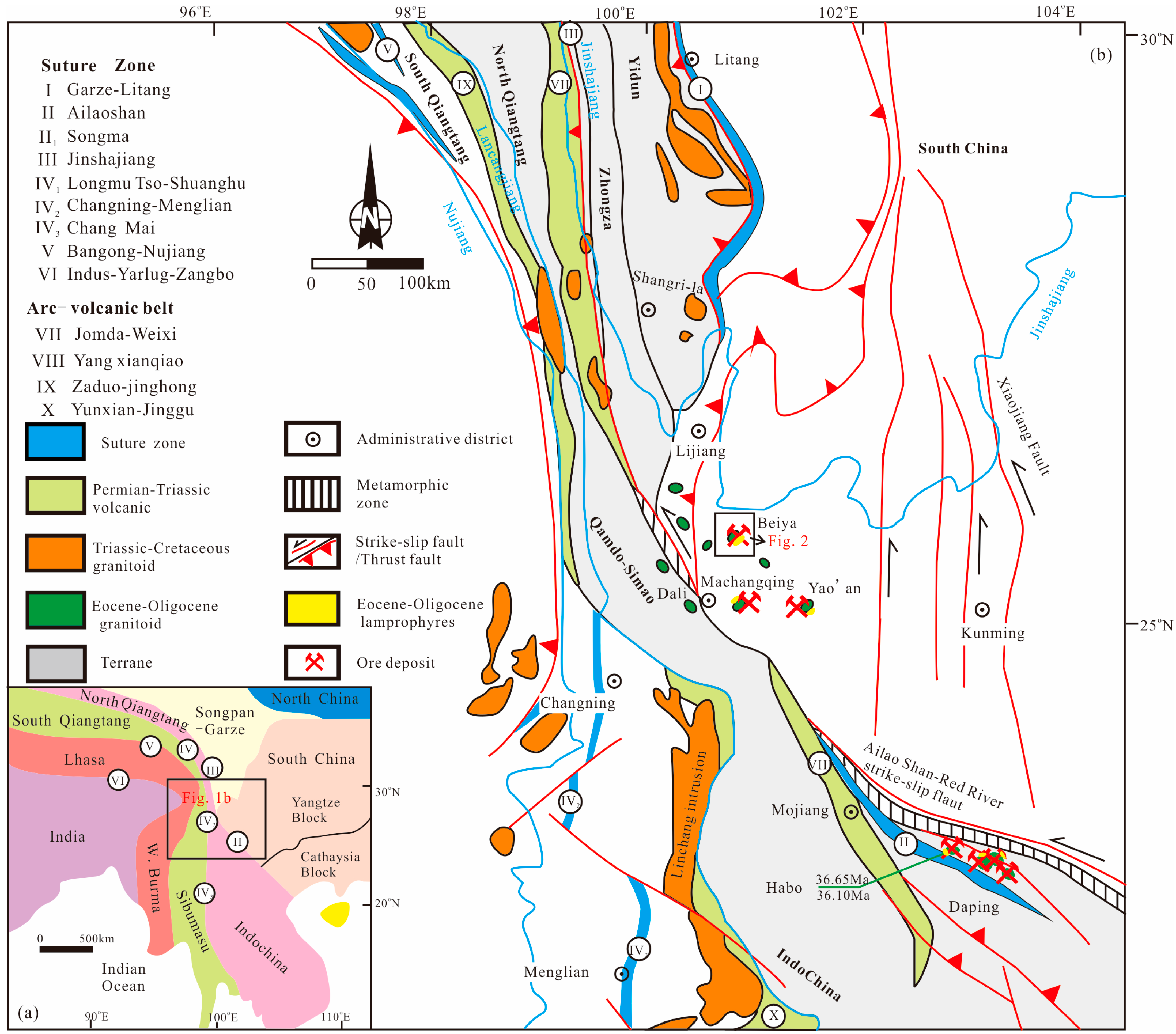
- (1)
- Metasomatized lithospheric mantle melting: Partial melting of metasomatized subcontinental lithospheric mantle due to the Indian plate’s eastward subduction [16] though crustal assimilation may be required to explain LILE (large ion lithophile elements)/LREE (light rare earth element) enrichment and HFSE (high-field strength element) depletion in some porphyries [15,17,18].
- (2)
- Hybrid source origin: Mixed mantle–crustal magmatism involving juvenile crust, ancient crustal materials, OIB (Ocean Island Basalt)/MORB (Mid-Ocean Ridge Basalt), or upper mantle components [17,19,20,21,22,23]. For instance, isotopic data from the Beiya gold district suggest a mixed source involving OIB, MORB, sedimentary rocks, and upper mantle [21]. Recent petrological and geochemical studies further confirm that the ore-bearing alkali-rich porphyries in the northern section of the JSJ-RR belt were likely derived from the partial melting of a Neoproterozoic lower crust with the input of enriched and depleted mantle-derived magmas [22].
- (3)
- Thickened mafic lower crust melting: Partial melting of thickened mafic lower crust, indicated by K2O, Y, Yb, Sr/Y (56.1–109) and low MgO and Cr (or Ni) values in Western Yunnan Cenozoic potassic felsic igneous rocks [24].
- (4)
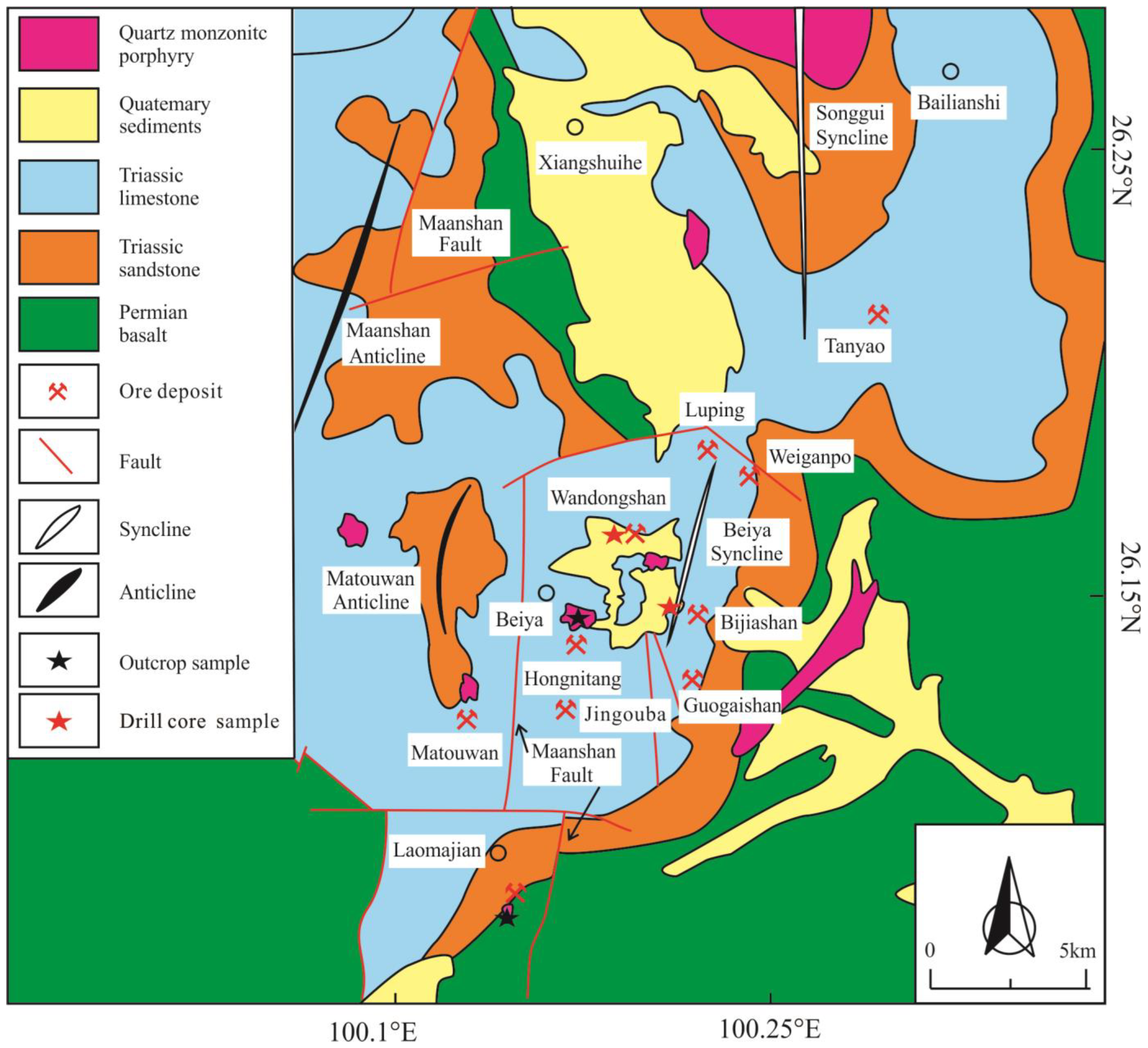
2. Geological Background and Sample Descriptions
2.1. Geological Background
2.2. Sample Descriptions
3. Analytical Methods
4. Results
4.1. Zircon U-Pb Dating
4.2. Whole-Rock Geochemical Compositions
4.3. Whole-Rock Sr-Nd and Zircon Hf Isotopic Compositions
5. Discussion
5.1. Chronological Significance of the Beiya Syenite Porphyry
5.2. Petrogenesis
5.2.1. Fractional Crystallization, Partial Melting, and Crustal Assimilation
5.2.2. Nature of Magma Sources
5.3. Genetic Model
- (1)
- Proterozoic subduction modification: Since the Neoarchean era, the continental margin of the Yangtze Craton has undergone multiple tectono-magmatic cycles associated with the supercontinents Columbia, Rodinia, Gondwana, and the Emeishan mantle plume [26]. Subsequent Proterozoic oceanic subduction beneath the craton introduced fluids into the lithospheric mantle, leading to the formation of hydrous mineral-enriched metasomatic domains crucial for subsequent magma formation [26].
- (2)
- Lithospheric thickening and erosion: Post-65 Ma India–Eurasia collision thickened the western Yunnan lithosphere [25], triggering gravitational instability that induced convective erosion of the lower lithospheric mantle. The consequent asthenospheric upwelling and extensional thinning provided thermodynamic conditions for mantle melting [69].
- (3)
- Mantle magma generation: Decompressional melting of upwelling asthenosphere transferred heat to the metasomatized subcontinental lithospheric mantle, generating shoshonitic/potassic mafic magmas [131].
- (4)
- Hybrid crustal melting: These mafic magmas underplated the ~55 km-thick lower crust, providing both incompatible element enrichment and thermal energy for partial melting of garnet amphibolite. The resulting hydrous melts ascended to form the Beiya porphyry at 37–33 Ma.
6. Conclusions
Supplementary Materials
Author Contributions
Funding
Data Availability Statement
Acknowledgments
Conflicts of Interest
References
- Deng, J.; Wang, Q.F.; Li, G.J.; Li, C.; Wang, C.M. Tethys tectonic evolution and its bearing on the distribution of important mineral deposits in the Sanjiang region, SW China. Gondwana Res. 2014, 26, 419–437. [Google Scholar] [CrossRef]
- Huang, X.L.; Niu, Y.L.; Xu, Y.G.; Chen, L.L.; Yang, Q.J. Mineralogical geochemical constraints on the petrogenesis of post-collisional potassic ultrapotassic rocks from western Yunnan SWChina. J. Petrol. 2010, 51, 1617–1654. [Google Scholar] [CrossRef]
- He, W.Y.; Mo, X.X.; He, Z.H.; White, N.C.; Chen, J.B.; Yang, K.H.; Wang, R.; Yu, X.H.; Dong, G.C.; Huang, X.F. The geology and mineralogy of the Beiya skarn gold deposit in Yunnan, Southwest China. Soc. Econ. Geol. 2015, 110, 1625–1641. [Google Scholar] [CrossRef]
- Yang, Z.; Yang, L.Q.; He, W.Y.; Gao, X.; Liu, X.D.; Bao, X.S.; Lu, Y.G. Control of magmatic oxidation state in intracontinental porphyry mineralization: A case from Cu (Mo-Au) deposits in the Jinshajiang-Red River metallogenic belt, SW China. Ore Geol. Rev. 2017, 90, 827–846. [Google Scholar] [CrossRef]
- Liu, J.L.; Chen, X.Y.; Tang, Y.; Tran, M.D.; Nguyen, Q.L.; Wu, W.B.; Zhang, Z.C.; Zhao, Z.D. New tectono-geochronological constraints on timing of shearing along the Ailao Shan-Red River shear zone: Implications for genesis of Ailao Shan gold mineralization. J. Asian Earth Sci. 2015, 103, 70–86. [Google Scholar] [CrossRef]
- Hou, Z.Q.; Zhong, D.L.; Deng, W.M.; Khin, Z. A tectonic model for porphyry copper-molybdenum-gold deposits in the eastern Indo-Asian collision zone//PORTERTM. In Super Porphyry Copper and Gold Deposits: A Global Perspective; PGC Publishing: Adelaide, Australia, 2004; pp. 423–440. [Google Scholar]
- Hou, Z.Q.; Zaw, K.; Pan, G.T.; Mo, X.X.; Xu, Q.; Hu, Y.Z.; Li, X.Z. Sanjiang Tethyan metallogenesis in SW China: Tectonic setting, metallogenic epochs and deposit types. Ore Geol. Rev. 2007, 31, 48–87. [Google Scholar] [CrossRef]
- He, W.Y.; Mo, X.X.; Yang, L.Q.; Xing, Y.L.; Dong, G.C.; Yang, Z.; Gao, X.; Bao, X.S. Origin of the Eocene porphyries and mafic microgranular enclaves from the Beiya porphyry Au polymetallic deposit, western Yunnan, China: Implications for magma mixing/mingling and mineralization. Gondwana Res. 2016, 40, 230–248. [Google Scholar] [CrossRef]
- Bao, X.S.; He, W.Y.; Mao, J.W.; Liang, T.; Wang, H.; Zhou, Y.M.; Wang, J.J. Redox states and genesis of Cu- and Au-mineralized granite porphyries in the Jinshajiang Cu-Au metallogenic belt, SW China: Studies on the zircon chemistry. Miner. Depos. 2023, 58, 1123–1142. [Google Scholar] [CrossRef]
- Xu, X.W.; Jiang, N.; Yang, K.; Zhang, B.L.; Liang, G.H.; Mao, Q.; Li, J.X.; Du, S.J.; Ma, Y.G.; Zhang, Y.; et al. Accumulated phenocrysts and origin of feldspar porphyry in the Chanho area, western Yunnan, China. Lithos 2009, 113, 595–611. [Google Scholar] [CrossRef]
- Liang, H.Y.; Campbell, I.H.; Allen, C.; Sun, W.D.; Zhang, Y.Q. Zircon Ce4+/Ce3+ ratios and ages for Yulong ore-bearing porphyries in eastern Tibet. Miner. Depos. 2006, 41, 152–159. [Google Scholar] [CrossRef]
- Zhang, Y.Q.; Xie, Y.W. Geochronology of Ailaoshan-Jinshajiang alkalirich intrusive rocks and their Sr and Nd isotopic characteristic. Sci. China Earth Sci. 1997, 40, 524–529. [Google Scholar] [CrossRef]
- Hou, Z.Q.; Zhou, Y.; Wang, R.; Zheng, Y.C.; Zhao, M.; Evans, N.J.; Weinberg, R.F. Recycling of metal-fertilized lower continental crust: Origin of non-arc Au-rich porphyry deposits at cratonic edges. Geology 2017, 45, 563–566. [Google Scholar] [CrossRef]
- Sun, C.D.; Wu, P.; Wang, D.; Guan, S.J.; Jiang, X.J.; Jiang, L.Y.; Wang, L.Y. Geochemistry and Zircon U-Pb age of the Yao’an pseudoleucite porphyry, Yunnan Province, China. Acta Geochim. 2017, 2, 194–206. [Google Scholar] [CrossRef]
- Yang, Z.M.; Cao, K. Post-collisional porphyry copper deposits in Tibet: An overview. Earth-Sci. Rev. 2024, 258, 104954. [Google Scholar] [CrossRef]
- Wang, J.; Yin, A.; Harrison, T.M.; Marty, G.; Zhang, Y.Q.; Xie, G.H. A tectonic model for Cenozoic igneous activities in the eastern Indo-Asian collision zone. Earth Planet. Sci. Lett. 2001, 188, 123–133. [Google Scholar] [CrossRef]
- Li, S.K.; Zhang, S.T.; Zhao, Q.H.; Li, M. Zircon U-Pb Chronology and Petrogeochemistry of Cenozoic Alkali-Rich Porphyry in Zaojiaochang, Lanping, Western Yunnan. J. Jilin Univ. (Earth Sci. Ed.) 2021, 51, 169–184, (In Chinese with English abstract). [Google Scholar]
- Li, Z.Q.; Zhang, P.P.; Zhou, K.W.; Zhang, J.W.; Yang, S.Z.; Wang, S.B.; Zou, Q.P.; Ma, Q.C.; Jiang, B.; Zhen, Y.L.; et al. Origin and geochemical characteristics of the porphyries in Beiya gold polymetallic deposit, Yunnan. Miner. Explor. 2023, 14, 849–860, (In Chinese with English abstract). [Google Scholar]
- Deng, W.M.; Huang, X.; Zhong, D.L. Alkali-rich porphyry and its relation with intraplate deformation of north part of Jinsha River. Sci. China (Ser. D Earth Sci.) 1998, 41, 297–305. [Google Scholar]
- Zhong, D.L.; Ding, L.; Liu, F.T.; Liu, J.H.; Zhang, J.J.; Ji, J.Q.; Chen, H. Multi-oriented and layered structures of lithosphere in orogenic belt and their effects on Cenozoic magmatism—A case study of western Yunnan and Sichuan, China. Sci. China (Ser. D Earth Sci.) 2000, 30, 122–133, (In Chinese with English abstract). [Google Scholar] [CrossRef]
- Xu, X.W.; Cai, X.P.; Song, B.C.; Zhang, B.L.; Ying, H.L.; Xiao, Q.B.; Wang, J. Petrologic, chronological and geochemistry characteristics and formation mechanism of alkaline porphyries in the Beiya gold district, western Yunnan. Acta Petrol. Sin. 2006, 22, 631–642, (in Chinese with English abstract). [Google Scholar]
- Yang, H.; Wang, D.; Wu, P.; Wang, F.; Chen, F.C. Petrogenesis of alkali-rich porphyry and its Cu-Mo-Au deposit formation—A case study of the Jinsha River-Honghe River porphyry metallogenic belt. Geol. Rev. 2023, 69, 1669–1693. [Google Scholar]
- Wu, J.; Zhao, Z.D.; Li, X.W.; Tu, X.W.; Li, C.; Lei, H.S.; Ma, Q.; Miao, Z.; Yang, Y.Y.; Liu, D.; et al. Re-melting of the Neoproterozoic juvenile mafic lower crust: The origin of adakitic and non-adakitic felsic suites in the southwest margin of Yangtze Craton. Lithos 2024, 474–475, 107601. [Google Scholar] [CrossRef]
- Tang, W.L.; Chen, J.L.; Tan, R.Y. Chronological and Geochemical Study of the Cenozoic Potassic Felsic Igneous Rocks in Western Yunnan, SE Tibet: Implications for their Tectonic Mechanisms. Acta Geol. Sin. (Engl. Ed.) 2022, 96, 904–918. [Google Scholar] [CrossRef]
- Hou, Z.Q.; Cook, N.J. Metallogenesis of the Tibetan collisional orogen: A review and introduction to the special issue. Ore Geol. Rev. 2009, 36, 2–24. [Google Scholar] [CrossRef]
- Xin, W. Research on Cenozoic Au-Cu-Mo Metallogenesis in Ailaoshan-Honghe Metallogenic Belt, Yunnan Province. Ph.D. Thesis, Jilin University, Jilin, China, 2020; pp. 1–216, (In Chinese with English abstract). [Google Scholar]
- Fu, Y.; Sun, X.M.; Lin, H.; Zhou, H.Y.; Li, X.; Ouyang, X.Q.; Jiang, L.Y.; Shi, G.Y.; Liang, Y.H. Geochronology of the giant Beiya gold-polymetallic deposit in Yunnan Province, Southwest China and its relationship with the petrogenesis of alkaline porphyry. Ore Geol. Rev. 2015, 71, 138–149. [Google Scholar] [CrossRef]
- Zhou, J.; Li, S.; Li, S.Z.; Wang, G.H.; Santosh, M.; Zhang, L.; Yu, S.Y.; Liu, Y.M.; Li, X.Y. Petrogenesis of Eocene mineralized porphyry in bijiashan, eastern margin of Tibet plateau: Constraints from geochronology, geochemistry and Hf isotopes. Lithos 2018, 316–317, 1–18. [Google Scholar]
- Hou, Z.Q.; Zhang, H.R.; Pan, X.F.; Yang, Z.M. Porphyry Cu (-Mo-Au) deposits related to melting of thickened mafic lower crust: Examples from the eastern Tethyan metallogenic domain. Ore Geol. Rev. 2011, 39, 21–45. [Google Scholar] [CrossRef]
- Mao, J.W.; Pirajno, F.; Lehmann, B.; Luo, M.C.; Berzina, A. Distribution of porphyry deposits in the Eurasian continent their corresponding tectonic settings. J. Asian Earth Sci. 2014, 79 (Pt B), 576–584. [Google Scholar] [CrossRef]
- Xu, X.W.; Cai, X.P.; Xiao, Q.B.; Peters, S.G. Porphyry Cu-Au and associated polymetallic Fe-Cu-Au deposits in the Beiya area, western Yunnan Province, South China. Ore Geol. Rev. 2007, 31, 224–246. [Google Scholar] [CrossRef]
- Fu, Y.; Sun, X.M.; Zhou, H.Y.; Lin, H.; Yang, T.J. In-situ LA-ICP-MS U-Pb geochronology and trace elements analysis of polygenetic titanite from the giant Beiya gold-polymetallic deposit in Yunnan Province, Southwest China. Ore Geol. Rev. 2016, 77, 43–56. [Google Scholar] [CrossRef]
- Zhou, J.X.; Dou, S.; Huang, Z.L.; Cui, Y.L.; Ye, L.; Li, B.; Gan, T.; Sun, H.R. Origin of the Luping Pb deposit in the Beiya area, Yunnan Province, SW China: Constraints from geology, isotope geochemistry and geochronology. Ore Geol. Rev. 2016, 72, 179–190. [Google Scholar] [CrossRef]
- Quan, H.H.; Chai, P.; Yuan, L.L.; Jiao, S.T. Petrogenesis Mineralization and Tectonic Implications of Paleoproterozoic Potassic-Ultrapotassic Magmatic Rocks in Western Yunnan. Gold Sci. Technol. 2024, 32, 220–240, (In Chinese with English abstract). [Google Scholar]
- Lu, Y.J.; Kerrich, R.; McCuaig, T.C.; Li, Z.X.; Hart, C.J.R.; Cawood, P.A.; Hou, Z.Q.; Bagas, L.; Cliff, J.; Belousova, E.A.; et al. Geochemical Sr-Nd-Pb zircon Hf-Oisotopic compositions of Eocene-Oligocene shoshonitic potassic adakite-like felsic intrusions in Western Yunnan SWChina: Petrogenesis tectonic implications. J. Petrol. 2013, 54, 1309–1348. [Google Scholar] [CrossRef]
- Liu, B.; Liu, H.; Zhang, C.Q.; Mao, Z.H.; Zhou, Y.M.; Huang, H.; He, Z.H.; Su, G.S. Geochemistry and geochronology of porphyries from the Beiya gold-polymetallic orefield, western Yunnan, China. Ore Geol. Rev. 2015, 69, 360–379. [Google Scholar] [CrossRef]
- Yin, A.; Harrison, T.M. Geologic Evolution of the Himalayan-Tibetan Orogen. Annu. Rev. Earth Planet. Sci. 2000, 28, 211–280. [Google Scholar] [CrossRef]
- Mo, X.X.; Dong, G.C.; Zhao, Z.D.; Guo, T.Y.; Wang, L.L.; Chen, T. Timing of magma mixing in the Gangdise magmatic belt during the India-Asia collision: Zircon shrimp U-Pb dating. Acta Geol. Sin. (Engl. Ed.) 2005, 79, 66–76. [Google Scholar]
- Chung, S.L.; Lo, C.H.; Lee, T.Y.; Zhang, Y.Q.; Xie, Y.W.; Li, X.H.; Wang, K.L.; Wang, P.L. Diachronous uplift of the Tibetan plateau starting 40 Myr ago. Nature 1998, 349, 769–773. [Google Scholar] [CrossRef]
- Lu, Y.J.; Kerrich, R.; Kemp, A.I.S.; McCuaig, T.C.; Hou, Z.Q.; Hart, C.J.R.; Li, Z.X.; Cawood, P.A.; Bagas, L.; Yang, Z.M.; et al. Intracontinental Eocene-Oligocene porphyry Cu mineral systems of Yunnan, Western Yangtze Craton, China: Compositional characteristics, sources, and implications for continental collision metallogeney. Soc. Econ. Geol. 2013, 108, 1541–1576. [Google Scholar] [CrossRef]
- Liu, H.; Wang, Q.F.; Li, G.J.; Wan, L. Characterization of multi-type mineralizations in the Wandongshan gold poly-metallic deposit, Yunnan (China), by fractal analysis. J. Geochem. Explor. 2012, 122, 20–33. [Google Scholar] [CrossRef]
- Deng, J.; Wang, Q.F.; Li, G.J.; Hou, Z.Q.; Jiang, C.Z.; Leonid, D. Geology and genesis of the giant Beiya porphyry-skarn gold deposit, northwestern Yangtze Block, China. Ore Geol. Rev. 2015, 70, 457–485. [Google Scholar] [CrossRef]
- Li, W.C.; Wang, J.H.; He, Z.H.; Dou, S. Formation of Au-polymetallic ore deposits in alkaline porphyries at Beiya, Yunnan, Southwest China. Ore Geol. Rev. 2015, 73, 241–252. [Google Scholar] [CrossRef]
- Yuan, Y.J.; Yin, Z.X.; Liu, W.L.; Huang, Q.T.; Li, J.F.; Liu, H.F.; Wan, Z.F.; Cai, Z.R.; Xia, B. Tectonic evolution of the Meso-Tethys in the western segment of Bangonghu-Nujiang suture zone: Insights from geochemistry and geochronology of the Lagkor Tso ophiolite. Acta Geol. Sin. (Engl. Ed.) 2015, 89, 369–388. [Google Scholar]
- Pearce, N.J.G.; Perkins, W.T.; Westgate, J.A.; Gorton, M.P.; Jackson, S.E.; Neal, C.R.; Chenery, S.P. A compilation of new and published major and trace element data for NIST 852 SRM 610 and NIST 853 SRM 612 glass reference materials. Geostand. Newsl. 1997, 21, 115–144. [Google Scholar] [CrossRef]
- Black, L.P.; Kamo, S.L.; Allen, C.M.; Aleinikoff, J.N.; Davis, D.W.; Korsch, R.J.; Foudoulis, C. TEMORA 1: A new zircon standard for Phanerozoic U-Pb geochronology. Chem. Geol. 2003, 200, 155–170. [Google Scholar] [CrossRef]
- Ludwig, K. User’s Manual for Isoplot 3.00: A Geochronological Toolkit for Microsoft Excel; Special Publication; Berkeley Geochronology Center: Berkeley, CA, USA, 2003; pp. 1–70. [Google Scholar]
- Liu, Y.S.; Hu, Z.C.; Gao, S.; Gunther, D.; Xu, J.; Gao, C.G.; Chen, H.H. In situ analysis of 812 major and trace elements of anhydrous minerals by LA-ICP-MS without applying an internal standard. Chem. Geol. 2008, 257, 34–43. [Google Scholar] [CrossRef]
- Huang, F.; Xu, J.F.; Zeng, Y.C.; Chen, J.L.; Wang, B.D.; Yu, H.X.; Chen, L.; Huang, W.L.; Tan, R.Y. Slab Breakoff of the Neo-Tethys Ocean in the Lhasa Terrane Inferred from Contemporaneous Melting of the Mantle and Crust. Geochem. Geophys. Geosystems 2017, 18, 4074–4095. [Google Scholar] [CrossRef]
- Huang, F.; Zhang, Z.; Xu, J.; Li, X.; Zeng, Y.; Wang, B.; Li, X.; Xu, R.; Fan, Z.; Tian, Y. Fluid flux in the lithosphere beneath southern Tibet during Neo-Tethyan slab breakoff: Evidence from an appinite-granite suite. Lithos 2019, 344–345, 324–338. [Google Scholar] [CrossRef]
- Jacobsen, S.B.; Wasserburg, G.J. Sm–Nd Isotopic Evolution of Chondrites. Earth Planet. Sci. 1980, 50, 139–155. [Google Scholar] [CrossRef]
- Lugmair, G.W.; Marti, K. Lunar initial 143Nd/144Nd: Differential evolution of the lunar crust and mantle. Earth Planet. Sci. 1978, 39, 349–357. [Google Scholar] [CrossRef]
- Li, X.H.; Long, W.G.; Li, Q.L.; Liu, Y.; Zheng, Y.F.; Yang, Y.H.; Chamberlain, K.R.; Wan, D.F.; Guo, C.H.; Wang, X.C.; et al. Penglai Zircon Megacrysts: A Potential New Working Reference Material for Microbeam Determination of Hf-O Isotopes and U-Pb Age. Geostand. Geoanalytical Res. 2010, 34, 117–134. [Google Scholar] [CrossRef]
- Blichert–Toft, J.; Albarède, F. The Lu–Hf geochemistry of chondrites and the evolution of the mantle–crust system. Earth Planet. Sci. 1997, 148, 243–258. [Google Scholar] [CrossRef]
- Griffin, W.L.; Pearson, N.J.; Belousova, E.; Jackson, S.E.; O’Reilly, S.Y.; Achterberg, E.; Shee, S.R. The Hf-isotope composition of cratonic mantle: LAM-MC-ICPMS analysis of zircon megacrysts in kimberlites. Geochim. Cosmochim. Acta 2000, 64, 133–147. [Google Scholar] [CrossRef]
- Söderlund, U.; Patchett, P.J.; Vervoort, J.D.; Isachsen, C.E. The 176Lu decay constant determined by Lu–Hf and U–Pb isotope systematics of Precambrian mafic intrusions. Earth Planet. Sci. 2004, 219, 311–324. [Google Scholar] [CrossRef]
- Yuan, H.L.; Gao, S.; Dai, M.N.; Zong, C.L.; Gunther, D.; Fontaine, G.H.; Liu, X.M.; Diwu, C. Simultaneous determinations of U-Pb age, Hf isotopes and trace element compositions of zircon by excimer laser-ablation quadrupole and multiple-collector ICP-MS. Chem. Geol. 2008, 247, 100–118. [Google Scholar] [CrossRef]
- Corfu, F.; Hanchar, J.M.; Hoskin, P.W.O.; Kinny, P. Atlas of zircon textures. Rev. Mineral. Geochem. 2003, 53, 469–500. [Google Scholar] [CrossRef]
- Wu, Y.B.; Zheng, Y.F. Genesis of zircon and its constraints on interpretation of U-Pb age. Chin. Sci. Bull. 2004, 49, 1554–1569. [Google Scholar] [CrossRef]
- Xu, S.M. Metallogenie Modeling of the Beiya Gold Deposit in WesternYunnan and Its Relation to the Cenozoic Alkali-Rich Porphyries: Beijing, China. Ph.D. Thesis, China University of Geosciences, Beijing, China, 2007; pp. 1–125, (in Chinese with English abstract). [Google Scholar]
- Streckeisen, A. To each plutonic rock its proper name. Earth-Sci. Rev. 1976, 12, 1–33. [Google Scholar] [CrossRef]
- Rickwood, P.C. Boundary lines within petrologic diagrams which use oxides of major and minor elements. Lithos 1989, 22, 247–263. [Google Scholar] [CrossRef]
- Le Maitre, R.W.; Bateman, P.; Dudek, A.; Keller, J.; Lameyre, J.; Le Bas, M.J.; Sabine, P.A.; Schmid, R.; Sorensen, H.; Streckeisen, A.; et al. A Classification of Igneous Rocks and Glossary of Terms: Recommendations of the International Union of Geological Sciences Subcommission on the Systematics of Igneous Rocks; Blackwell: Oxford, UK, 1989. [Google Scholar]
- Maniar, P.D.; Piccoli, P.M. Tectonic discrimination of granitoids. Geol. Soc. Am. Bull. 1989, 101, 635–643. [Google Scholar] [CrossRef]
- Wang, Q.; Xu, J.F.; Jian, P.; Bao, Z.W.; Zhao, Z.H.; Li, C.F.; Xiong, X.L.; Ma, J.L. Petrogenesis of adakitic porphyries in an extensional tectonic setting Dexing South China: Implications for the genesis of porphyry copper mineralization. J. Petrol. 2006, 47, 119–144. [Google Scholar] [CrossRef]
- Lu, Y.J.; McCuaiga, T.C.; Li, Z.X.; Jourdan, F.; Hart, C.J.R.; Hou, Z.Q.; Tang, S.H. Paleogene post-collisional lamprophyres in western Yunnan, western Yangtze Craton: Mantle source and tectonic implications. Lithos 2015, 233, 139–161. [Google Scholar] [CrossRef]
- Zhu, X.P.; Mo, X.X.; White, N.C.; Zhang, B.; Sun, M.X.; Wang, S.X.; Zhao, S.L.; Yang, Y. Petrogenesis metallogenic setting of the Habo porphyry Cu-(Mo-Au) deposit Yunnan China. J. Asian Earth Sci. 2013, 66, 188–203. [Google Scholar] [CrossRef]
- Chen, Y.; Yao, S.; Pan, Y. Geochemistry of lamprophyres at the Daping gold deposit Yunnan Province China: Constraints on the timing of gold mineralization evidence for mantle convection in the eastern Tibetan Plateau. J. Asian Earth Sci. 2014, 93, 129–145. [Google Scholar] [CrossRef]
- He, W.Y.; Mo, X.X.; Yu, X.H.; Dong, G.C.; He, Z.H.; Huang, X.F.; Li, X.W.; Jiang, L.L. Genesis and geodynamic settings of lamprophyres from Beiya, western Yunnan: Constraints from geochemistry, geochronology and Sr-Nd-Pb-Hf isotopes. Acta Petrol. Sin. 2014, 30, 3287–3300, (In Chinese with English abstract). [Google Scholar]
- Jia, L.Q.; Mo, X.X.; Dong, G.C.; Xu, W.Y.; Wang, L.; Guo, X.D.; Wang, Z.H.; Wei, S.G. Genesis of lamprophyres from Machangqing, western Yunnan: Constraints from geochemistry, geochronology and Sr-Nd-Pb-Hf isotopes. Acta Petrol. Sin. 2013, 29, 1247–1260, (In Chinese with English abstract). [Google Scholar]
- Gan, T.; Huang, Z. Platinum-group element and Re-Os geochemistry of lamprophyres in the Zhenyuan gold deposit, Yunnan province, China: Implications for petrogenesis and mantle evolution. Lithos 2017, 282–283, 228–239. [Google Scholar] [CrossRef]
- Sun, S.S.; McDonough, W.F. Chemical and isotopic systematics of oceanic basalt: Implications for mantle composition and processes. Geol. Soc. Lond. Spec. Publ. 1989, 42, 313–345. [Google Scholar] [CrossRef]
- Arnaud, N.O.; Vidal, P.; Tapponnier, P.; Matte, P.; Deng, W.M. The high K2O volcanism of northwestern Tibet: Geochemistry and tectonic implications. Earth Planet. Sci. Lett. 1992, 111, 351–367. [Google Scholar] [CrossRef]
- Turner, S.; Arnaud, N.; Liu, J.; Rogers, N.; Hawkesworth, C.; Harris, N.; Kelley, S.; van Calsteren, P.; Deng, W.M. Postcollisional, shoshonitic volcanism on the Tibetan plateau: Implications for convective thinning of the lithosphere and the source of ocean island basalts. J. Petrol. 1996, 37, 45–71. [Google Scholar] [CrossRef]
- Guo, Z.F.; Wilson, M.; Liu, J.Q.; Mao, Q. Post-collisional potassic ultrapotassic magmatism of the northern Tibetan plateau: Constraints on characteristics of the mantle source geodynamic setting uplift mechanisms. J. Petrol. 2006, 47, 1177–1220. [Google Scholar] [CrossRef]
- Miller, C.; Schuster, R.; Klotzli, U.; Frank, W.; Purtscheller, F. Post-collisional potassic ultrapotassic magmatism in SWTibet: Geochemical Sr-Nd-Pb-Oisotopic constraints for mantle source characteristics petrogenesis. J. Petrol. 1999, 40, 1399–1424. [Google Scholar] [CrossRef]
- Ding, L.; Kapp, P.; Zhong, D.L.; Deng, W.M. Cenozoic volcanism in Tibet: Evidence for a transition from oceanic to continental subduction. J. Petrol. 2003, 44, 1833–1865. [Google Scholar] [CrossRef]
- Zhao, Z.D.; Mo, X.X.; Dilek, Y.; Niu, Y.L.; DePaolo, D.J.; Robinson, P.; Zhu, D.C.; Sun, C.G.; Dong, G.C.; Zhou, S.; et al. Geochemical and Sr-Nd-Pb-O isotopic compositions of the post-collisional ultrapotassic magmatism in SW Tibet: Petrogenesis and implications for India intra-continental subduction beneath southern Tibet. Lithos 2009, 113, 190–212. [Google Scholar] [CrossRef]
- Guo, Z.F.; Wilson, M.; Zhang, M.L.; Cheng, Z.H.; Zhang, L.H. Post-collisional ultrapotassic mafic magmatism in South Tibet: Products of partial melting of pyroxenite in the mantle wedge induced by roll-back delamination of the subducted Indian continental lithosphere slab. J. Petrol. 2015, 56, 1365–1406. [Google Scholar] [CrossRef]
- Zindler, A.; Hart, S. Chemical geodynamics. Annu. Rev. Earth Planet. Sci. 1986, 14, 493–571. [Google Scholar] [CrossRef]
- Hofmann, A.W. Mantle geochemistry: The message from oceanic volcanism. Nature 1997, 385, 219–229. [Google Scholar] [CrossRef]
- Wu, F.Y.; Li, X.H.; Zheng, Y.F.; Gao, S. Lu-Hf isotopic systematics and their applications in petrology. Acta Petrol. Sin. 2007, 23, 185–220, (in Chinese with English abstract). [Google Scholar]
- Sun, X.M.; Zhang, Y.; Xiong, D.X.; Sun, W.D.; Shi, G.Y.; Zhai, W.; Wang, S.W. Crust and mantle contributions to gold-forming process at the Daping deposit, Ailaoshan gold belt, Yunnan, China. Ore Geol. Rev. 2009, 36, 235–249. [Google Scholar] [CrossRef]
- Zhao, X.F.; Zhou, M.F.; Li, J.W.; Sun, M.; Gao, J.F.; Sun, W.H.; Yang, J.H. Late Paleoproterozoic to early Mesoproterozoic Dongchuan Group in Yunnan, SW China: Implications for tectonic evolution of the Yangtze Block. Precambrian Res. 2010, 182, 57–69. [Google Scholar] [CrossRef]
- Wang, X.C.; Li, X.H.; Li, Z.X.; Li, Q.L.; Tang, G.Q.; Gao, Y.Y.; Zhang, Q.R.; Liu, Y. Episodic Precambrian crust growth: Evidence from U-Pb ages and Hf-O isotopes of zircon in the Nanhua Basin, central South China. Precambrian Res. 2012, 222–223, 386–403. [Google Scholar] [CrossRef]
- Wang, D.H.; Chen, Y.C.; Xu, J.; Yang, J.M.; Xue, C.J.; Yan, S.H. Characteristic and metallogenic series of Cenozoic metallogeny in China. In Proceedings of the 31st International Geological Congress: Chinese Contributions to the Congress, Rio de Janeiro, Brazil, 6–17 August 2001; pp. 264–269. (In Chinese). [Google Scholar]
- Yang, J.M.; Xue, C.J.; Xu, J.; Chen, Y.C.; Wang, D.H. Geology and Metallogenesis of Himalayan Alkali-Rich Porphyries in Northwestern Yunnan; Himalayan Endogenic Mineralization Research; Chen, Y.C., Wang, D.H., Eds.; Geological Publishing House: Beijing, China, 2001; pp. 57–68. (In Chinese) [Google Scholar]
- Lu, Y.J.; Kerrich, R.; Cawood, P.A.; McCuaig, T.C.; Hart, C.J.R.; Li, Z.X.; Hou, Z.Q.; Bagas, L. Zircon SHRIMP U-Pb geochronology of potassic felsic intrusions in western Yunnan, SW China: Constraints on the relationship of magmatism to the Jinsha suture. Gondwana Res. 2012, 22, 737–747. [Google Scholar] [CrossRef]
- Chung, S.L.; Chu, M.F.; Zhang, Y.Q.; Xie, Y.W.; Lo, C.H.; Lee, T.Y.; Lan, C.Y.; Li, X.H.; Zhang, Q.; Wang, Y.Z. Tibetan tectonic evolution inferred from spatial and temporal variations in post-collisional magmatism. Earth-Sci. Rev. 2005, 68, 173–196. [Google Scholar] [CrossRef]
- Xia, B.; Lu, Y.; Yuan, Y.J.; Chen, W.Y.; Zhang, X.; Xu, C.; Yu, S.R.; Wan, Z.F. Mixing of Enriched Lithospheric Mantle-Derived and Crustal Magmas: Evidence from the Habo Cenozoic Porphyry in Western Yunnan. Acta Geol. Sin. (Engl. Ed.) 2018, 92, 1753–1768. [Google Scholar] [CrossRef]
- Yan, Q.G.; Jiang, X.J.; Li, C.; Zhou, L.M.; Wang, Z.Q.; Sher, S.B.; Qu, W.J.; Du, A.D. Geodynamic background of intracontinental Cenozoic Alkaline volcanic rocks in Laojiezi, Western Yangtze Craton: Constraints from Sr-Nd-Hf-O isotopes. Acta Geol. Sin.-Engl. Ed. 2018, 92, 2098–2119. [Google Scholar]
- Schärer, U.; Tapponnier, P.; Lacassin, R.; Leloup, P.H.; Zhong, D.; Ji, S. Intraplate tectonics in Asia: A precise age for large-scale Miocene movement along the Ailao Shan-Red River shear zone, China. Earth Planet. Sci. Lett. 1990, 97, 65–77. [Google Scholar] [CrossRef]
- Schärer, U.; Zhang, L.C.; Tapponnier, P. Duration of strike-slip movements in large shear zones: The Red River belt, China. Earth Planet. Sci. Lett. 1994, 126, 379–397. [Google Scholar] [CrossRef]
- Harrison, T.M.; Chen, W.; Leloup, P.H.; Ryerson, F.J.; Tapponnier, P. An early Miocene transition in deformation regime within the Red River fault zone Yunnan its significance for the Indo-Asian tectonics. J. Geophys. Res. 1992, 97, 7159–7182. [Google Scholar] [CrossRef]
- Zhang, L.S.; Schärer, U. Age and origin of magmatism along the Cenozoic Red River shear belt. China. Contrib. Mineral. Petrol. 1999, 134, 67–85. [Google Scholar] [CrossRef]
- Gilley, L.D.; Harrison, T.M.; Leloup, P.H.; Ryerson, F.J.; Lovera, O.M.; Wang, J.H. Direct dating of left-lateral deformation along the Red River shear zone China Vietnam. J. Geophys. Res. 2003, 108, 14–21. [Google Scholar] [CrossRef]
- Sassier, C.; Leloup, P.H.; Rubatto, D.; Galland, O.; Yahui, Y.; Ding, L. Direct measurement of strain rates in ductile shear zones: Anew method based on syntectonic dikes. J. Geophys. Res. 2009, 114, B01406. [Google Scholar] [CrossRef]
- Searle, M.; Yeh, M.; Lin, T.H.; Chung, S.L. Structural constraints on the timing of left-lateral shear along the Red River shear zone in the Ailao Shan and Diancang Shan ranges, Yunnan, SW China. Geosphere 2010, 6, 316–338. [Google Scholar] [CrossRef]
- Cao, S.Y.; Liu, J.L.; Leiss, B.; Neubauer, F.; Genser, J.; Zhao, C.Q. Oligo-Miocene shearing along the Ailao Shan-Red River shear zone: Constraints from structural analysis and zircon U/Pb geochronology of magmatic rocks in the Diancang Shan massif, SE Tibet, China. Gondwana Res. 2011, 19, 975–993. [Google Scholar] [CrossRef]
- Chung, S.L.; Chu, M.F.; Ji, J.Q.; O’Reilly, S.Y.; Pearson, N.J.; Liu, D.Y.; Lee, T.Y.; Lo, C.H. The nature and timing of crustal thickening in southern Tibet: Geochemical and zircon Hf isotopic constraints from post-collisional adakites. Tectonophysics 2009, 477, 36–48. [Google Scholar] [CrossRef]
- Li, X.Z.; Yin, C.Q.; Gao, P.; Davis, D.W.; Li, S.; Zhang, J.; Qian, J.H.; Zhang, Y.L. Petrogenesis tectonic implications of Eocene-Oligocene potassic felsic porphyries in the Sanjiang region southeastern Tibetan Plateau. J. Asian Earth Sci. 2022, 232, 105209. [Google Scholar] [CrossRef]
- Campbell, I.H.; Grifiths, R.W. The evolution of mantle’s chemical stmucture. Lithos 1993, 30, 389–399. [Google Scholar] [CrossRef]
- Baker, J.A.; Menzine, M.A.; Thirlwall, M.F.; Macpherson, C.G. Petrogenesic of quaternary intraplate volcanism Sana’s Yemen:Implication polybaric melt hybridization. J. Petrol. 1997, 38, 1359–1390. [Google Scholar] [CrossRef]
- Macdonald, R.; Rogers, N.W.; Fitton, J.G. Plume-lithosphere interaction in the generation of the basalts of the Kenya rift east Afica. J. Petrol. 2001, 42, 877–900. [Google Scholar] [CrossRef]
- Taylor, S.R.; Mclennan, S.M. The continental crust: Its composition evolution. J. Geol. 1985, 94, 57–72. [Google Scholar]
- Liu, Z.; Liao, S.Y.; Wang, J.R.; Ma, Z.; Liu, Y.X.; Wang, D.B.; Tang, Y.; Yang, J. Petrogenesis of late Eocene high Ba-Sr potassic rocks from western Yangtze Block SETibet: Amagmatic response to the Indo-Asian collision. J. Asian Earth Sci. 2017, 135, 95–109. [Google Scholar] [CrossRef]
- Zhao, X.; Yu, X.H.; Mo, X.X.; Zhang, J.; Lv, B.X. Petrological and geochemical characteristics of Cenozoic alkali-rich porphyries and xenoliths hosted in western Yunnan province. Geoscience 2004, 18, 217–228. [Google Scholar]
- Xin, T.; Zhao, Z.D.; Niu, Y.L.; Zhang, S.Q.; Cousens, B.; Liu, D.; Zhang, Y.; Han, M.Z.; Zhao, Y.X.; Lei, H.S.; et al. Petrogenesis and tectonic implications of the Eocene-Oligocene potassic felsic suites in western Yunnan, eastern Tibetan Plateau: Evidence from petrology, zircon chronology, elemental and Sr-Nd-Pb-Hf isotopic geochemistry. Lithos 2019, 340–341, 287–315. [Google Scholar]
- Zhou, Y.; Xu, B.; Hou, Z.Q.; Wang, R.; Zheng, Y.C.; He, W.Y. Petrogenesis of Cenozoic high-Sr/Y shoshonites and associated mafic microgranular enclaves in an intracontinental setting: Implications for porphyry Cu-Au mineralization in western Yunnan, China. Lithos 2019, 324/325, 39–54. [Google Scholar] [CrossRef]
- Zhou, Y.; Hou, Z.Q.; Wang, R.; Xu, B.; Evans, N.J.; He, W.Y.; Zheng, Y.C.; Zhou, J.X. Origin of biotite-rich xenoliths in the Eocene Beiya porphyry: Implications for upper-crustal Au remobilization and formation of giant porphyry Au systems in a collisional setting. Lithos 2023, 442, 107063. [Google Scholar] [CrossRef]
- Yang, M.M.; Zhao, F.F.; Liu, X.F.; Qing, H.R.; Chi, G.X.; Li, X.Y.; Duan, W.J.; Lai, C. Contribution of magma mixing to the formation of porphyry-skarn mineralization in a post-collisional setting: The Machangqing Cu-Mo-(Au) deposit, Sanjiang tectonic belt, SW China. Ore Geol. Rev. 2020, 122, 103518. [Google Scholar] [CrossRef]
- Xu, L.L.; Zhu, J.J.; Huang, M.L.; Pan, L.C.; Hu, R.Z.; Bi, X.W. Genesis of hydrous-oxidized parental magmas for porphyry Cu (Mo, Au) deposits in a postcollisional setting: Examples from the Sanjiang region, SW China. Miner. Depos. 2023, 58, 161–196. [Google Scholar] [CrossRef]
- Zhang, Q.; Jin, W.J.; Xiong, X.L.; Li, C.D.; Wang, Y.L. Characteristics and implication of O-Type Adakite in China during different geological periods. Geotecton. Et Metallog. 2009, 33, 432–447, (in Chinese with English abstract). [Google Scholar]
- Defant, M.J.; Drummond, M.S. Derivation of some modern arc magmas by melting of young subducted lithosphere. Nature 1990, 347, 662–665. [Google Scholar] [CrossRef]
- Zhang, Q.; Wang, Y.; Liu, W.; Wang, L.W. Adakite: Its characteristics and implications. Geol. Bull. China 2002, 21, 431–435, (in Chinese with English abstract). [Google Scholar]
- Chung, S.L.; Liu, D.; Ji, J.Q.; Chu, M.F.; Lee, T.Y.; Wen, D.J.; Zhang, Q. Adakites from continental collision zones: Melting of thickened lower crust beneath southern Tibet. Geology 2003, 31, 1021–1024. [Google Scholar] [CrossRef]
- Atherton, M.P.; Petford, N. Generation of sodium-rich magmas from newly underplated basaltic crust. Nature 1993, 362, 144–146. [Google Scholar] [CrossRef]
- Muir, R.J.; Weaver, S.D.; Bradshaw, J.D.; Eby, G.N.; Evans, J.A. The Cretaceous Separation Point batholith New Zealand: Granitoid magmas formed by melting of mafic lithosphere. J. Geol. Soc. 1995, 152, 689–701. [Google Scholar] [CrossRef]
- Xu, J.F.; Shinjo, R.; Defant, M.J.; Wang, Q.; Rapp, R.P. Origin of Mesozoic adakitic intrusive rocks in the Ningzhen area of East China: Partial melting of delaminated lower continental crust? Geology 2002, 30, 1111–1114. [Google Scholar] [CrossRef]
- Jahn, B.M.; Zhang, Z.Q. Archean granulite gneisses from eastern Hebei Province, China: Rare earth geochemistry and tectonic implications. Contrib. Mineral. Petrol. 1984, 85, 224–243. [Google Scholar] [CrossRef]
- Baker, M.B.; Hirschmann, M.M.; Ghiorso, M.S.; Stolper, E.M. Compositions of near-solidus peridotite melts from experiments and thermodynamic calculations. Nature 1995, 375, 308–311. [Google Scholar] [CrossRef]
- Valley, J.W.; Lackey, J.S.; Cavosie, A.J.; Clechenko, C.C.; Apicuzza, M.J.; Basei, M.A.S.; Bindeman, I.N.; Ferreira, V.P.; Sial, A.N.; King, E.M.; et al. 4.4 billion years of crustal maturation: Oxygen isotope ratios of magmatic zircon. Contrib. Mineral. Petrol. 2005, 150, 561–580. [Google Scholar] [CrossRef]
- King, P.L.; White, A.J.R.; Chappell, B.W.; Allen, C.M. Characterization origin of aluminous A-type granites from the Lachlan Fold Belt southeastern Australia. J. Petrol. 1997, 38, 371–391. [Google Scholar] [CrossRef]
- Patiño Douce, A.E. Generation of metaluminous A-type granites by low pressure melting of calc-alkaline granitoids. Geology 1997, 25, 743–746. [Google Scholar] [CrossRef]
- Wu, F.Y.; Sun, D.Y.; Li, H.M.; Jahn, B.M.; Wilde, S.A. A-type granites in northeastern China: Age and geochemical constraints on their petrogenesis. Chem. Geol. 2002, 187, 143–173. [Google Scholar] [CrossRef]
- Yang, L.Q.; Deng, J.; Dilek, Y.; Meng, J.Y.; Gao, X.; Santosh, M.; Wang, D.; Yan, H. Melt source and evolution of I-type granitoids in the SE Tibetan Plateau: Late Cretaceous magmatism and mineralization driven by collision-induced transtensional tectonics. Lithos 2016, 245, 258–273. [Google Scholar] [CrossRef]
- Bea, F.; Fershtater, G.B.; Montero, P.; Whitehouse, M.; Levin, V.Y.; Scarrow, J.H.; Austrheim, H.; Pushkariev, E.V. Recycling of continental crust into the mantle as revealed by Kytlym dunite zircons, Ural Mts, Russia. Terra Nova 2001, 13, 407–412. [Google Scholar] [CrossRef]
- Chen, Q.; Sun, M.; Zhao, G.C.; Zhao, J.H.; Zhu, W.L.; Long, X.P.; Wang, J. Episodic crustal growth and reworking of the Yudongzi terrane, South China: Constraints from the Archean TTGs and potassic granites and Paleoproterozoic amphibolites. Lithos 2019, 326–327, 1–18. [Google Scholar] [CrossRef]
- Zheng, Y.F.; Zhao, G. Two styles of plate tectonics in Earth’s history. Sci. Bull. 2020, 65, 329–334. [Google Scholar] [CrossRef] [PubMed]
- Guo, Z.F.; Wilson, M.; Liu, J. Post-collisional adakites in South Tibet: Products of partial melting of subduction-modified lower crust. Lithos 2007, 96, 205–224. [Google Scholar] [CrossRef]
- Wang, X.; Zhang, J.F.; Rushmer, T.; Adam, J.; Turner, S. Adakite-Like Potassic Magmatism Crust-MantleInteraction in a Postcollisional Setting: An Experimental Study of MeltingBeneath the Tibetan Plateau. J. Geophys. Res. Solid Earth 2019, 124, 12782–12798. [Google Scholar] [CrossRef]
- Pearce, J.A. Sources and settings of granitic rocks. Episodes 1996, 19, 120–125. [Google Scholar] [CrossRef]
- Gomez-Frutos, D.; Castro, A. Mafic microgranular enclaves (MMEs) trace the origin of post-collisional magmas. Geology 2023, 8, 51. [Google Scholar] [CrossRef]
- Conticelli, S.; Guarnieri, L.; Farinelli, A.; Mattei, M.; Avanzinelli, R.; Bianchini, G.; Boari, E.; Tommasini, S.; Tiepolo, M.; Prelević, D.; et al. Trace elements and Sr-Nd-Pb isotopes of K-rich, shoshonitic, and calc-alkaline magmatism of the Western Mediterranean Region: Genesis of ultrapotassic to calc-alkaline magmatic associations in a post-collisional geodynamic setting. Lithos 2009, 107, 68–92. [Google Scholar] [CrossRef]
- Topuz, G.; Altherr, R.; Schwarz, W.H.; Siebel, W.; Satır, M.; Dokuz, A. Post-collisional plutonism with adakite-like signatures: The Eocene Saraycık granodiorite (Eastern Pontides, Turkey). Contrib. Mineral. Petrol. 2005, 150, 441–455. [Google Scholar] [CrossRef]
- Wang, R.; Weinberg, R.F.; Collins, W.J.; Richards, J.P.; Zhu, D.C. Origin of postcollisional magmas and formation of porphyry Cu deposits in southern Tibet. Earth-Sci. Rev. 2018, 181, 122–143. [Google Scholar] [CrossRef]
- Liégeois, J.P.; Navez, J.; Hertogen, J.; Blank, R. Contrasting origin of post-collisional high-K calc-alkaline and shoshonitic versus alkaline and peralkaline granitoids. Use Sliding normalization. Lithos 1998, 45, 1–28. [Google Scholar] [CrossRef]
- Deng, J.; Su, S.; Niu, Y.; Liu, C.; Zhao, G.C.; Zhao, X.G.; Zhou, S.; Wu, Z.X. A possible model for the lithospheric thinning of North China Craton: Evidence from the Yanshanian (Jura-Cretaceous) magmatism and tectonism. Lithos 2007, 96, 22–35. [Google Scholar] [CrossRef]
- Liu, J.Q. Volcanoes in China; Science Press: Beijing, China, 1999; pp. 1–219. (In Chinese) [Google Scholar]
- Zhang, Y.Q.; Xie, Y.W.; Li, X.H.; Qiu, H.N.; Zhao, Z.H.; Liang, H.Y.; Chung, S. Isotopic characteristics of shoshonitic rocks in eastern Qinghai-Tibet Plateau: Petrogenesis and its tectonic implication. Sci. China (Ser. D) 2001, 44, 1–6. [Google Scholar] [CrossRef]
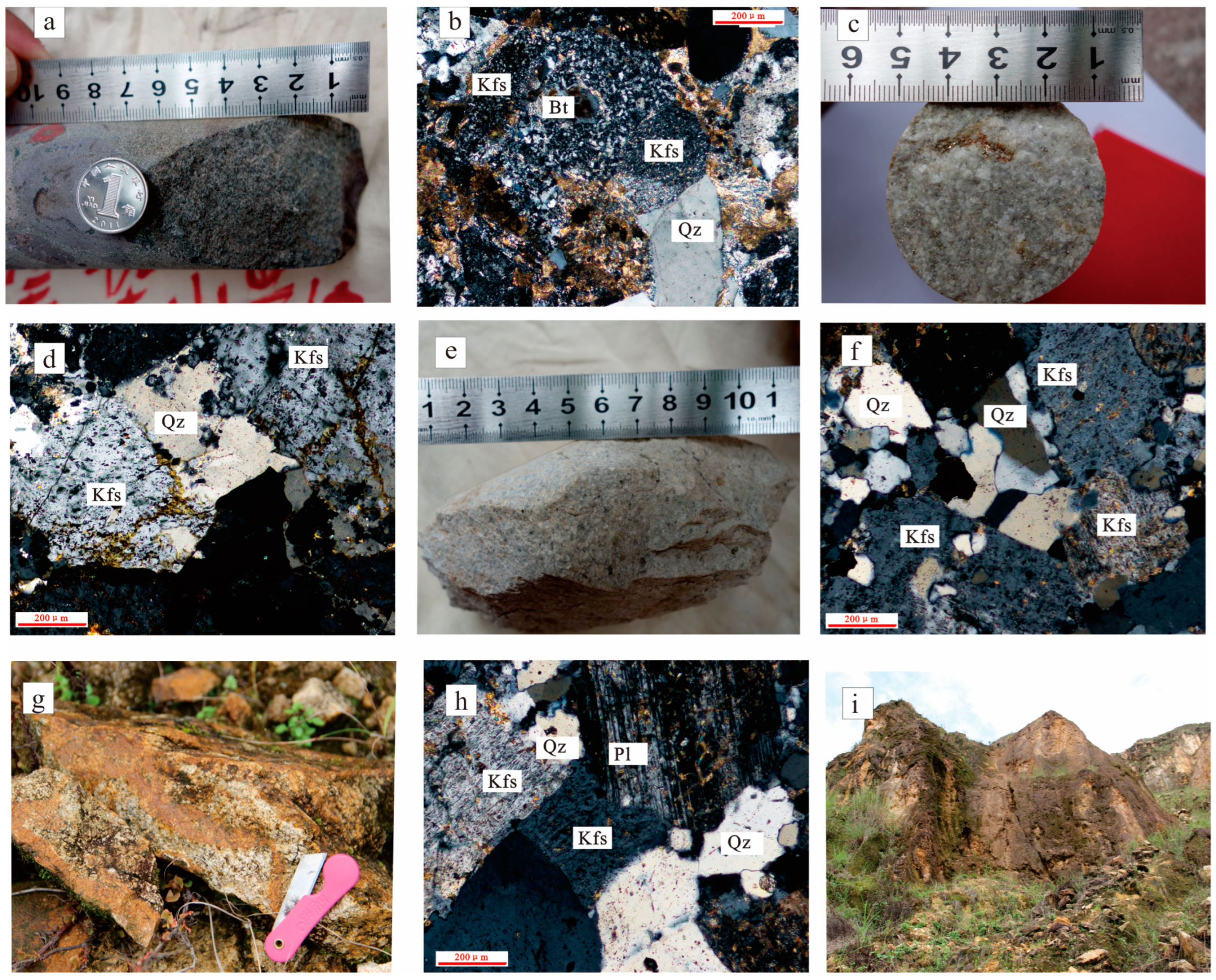
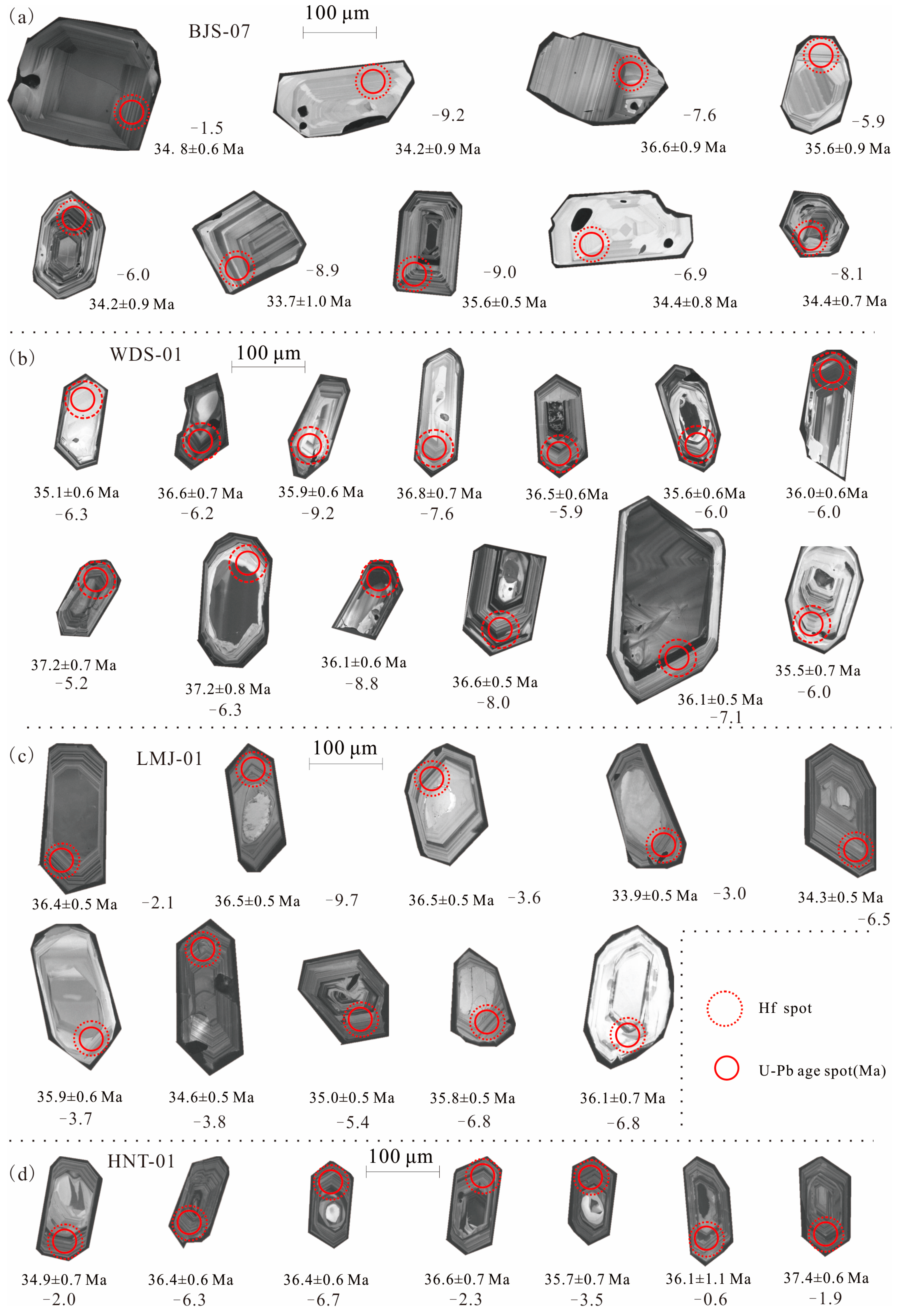
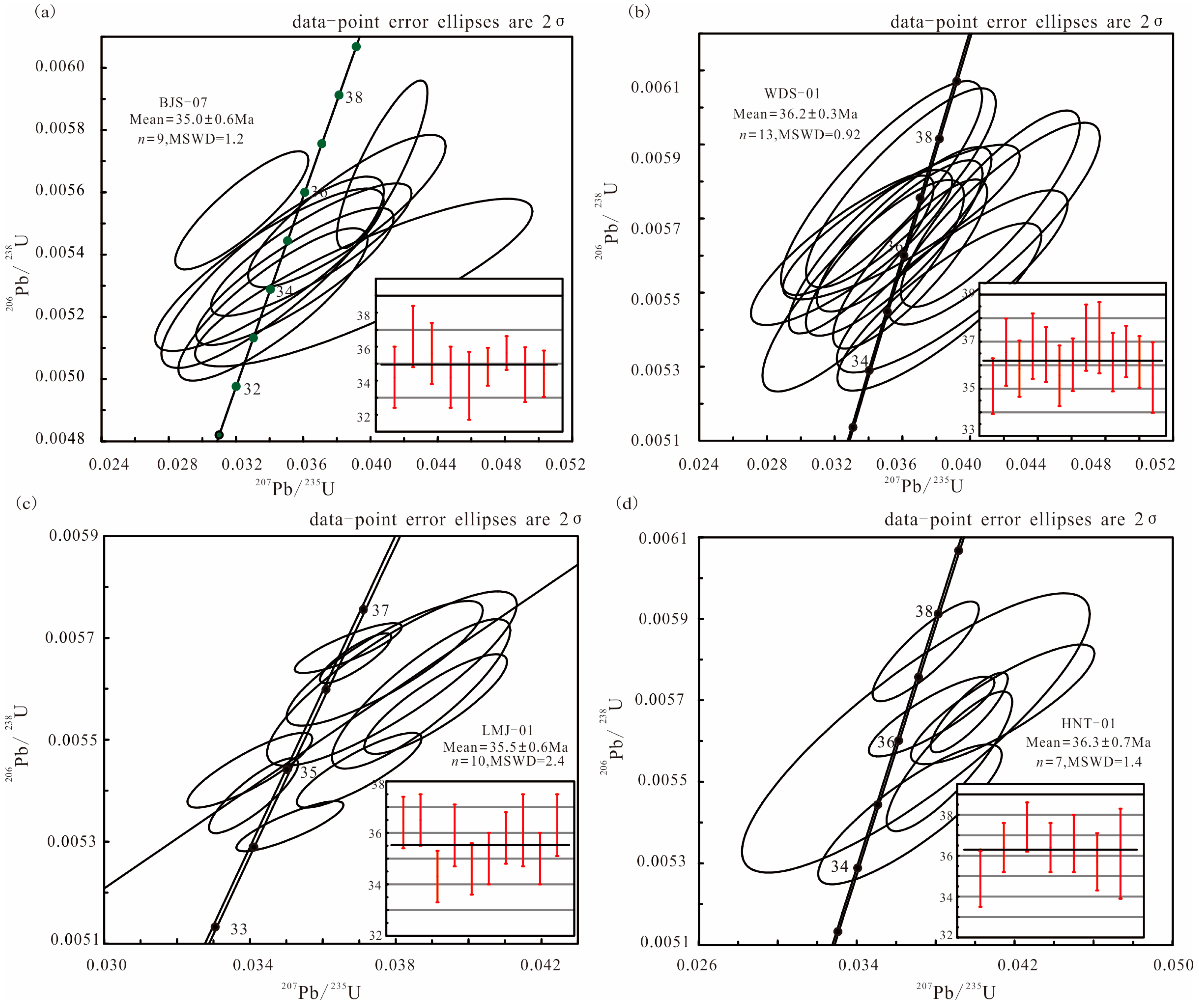
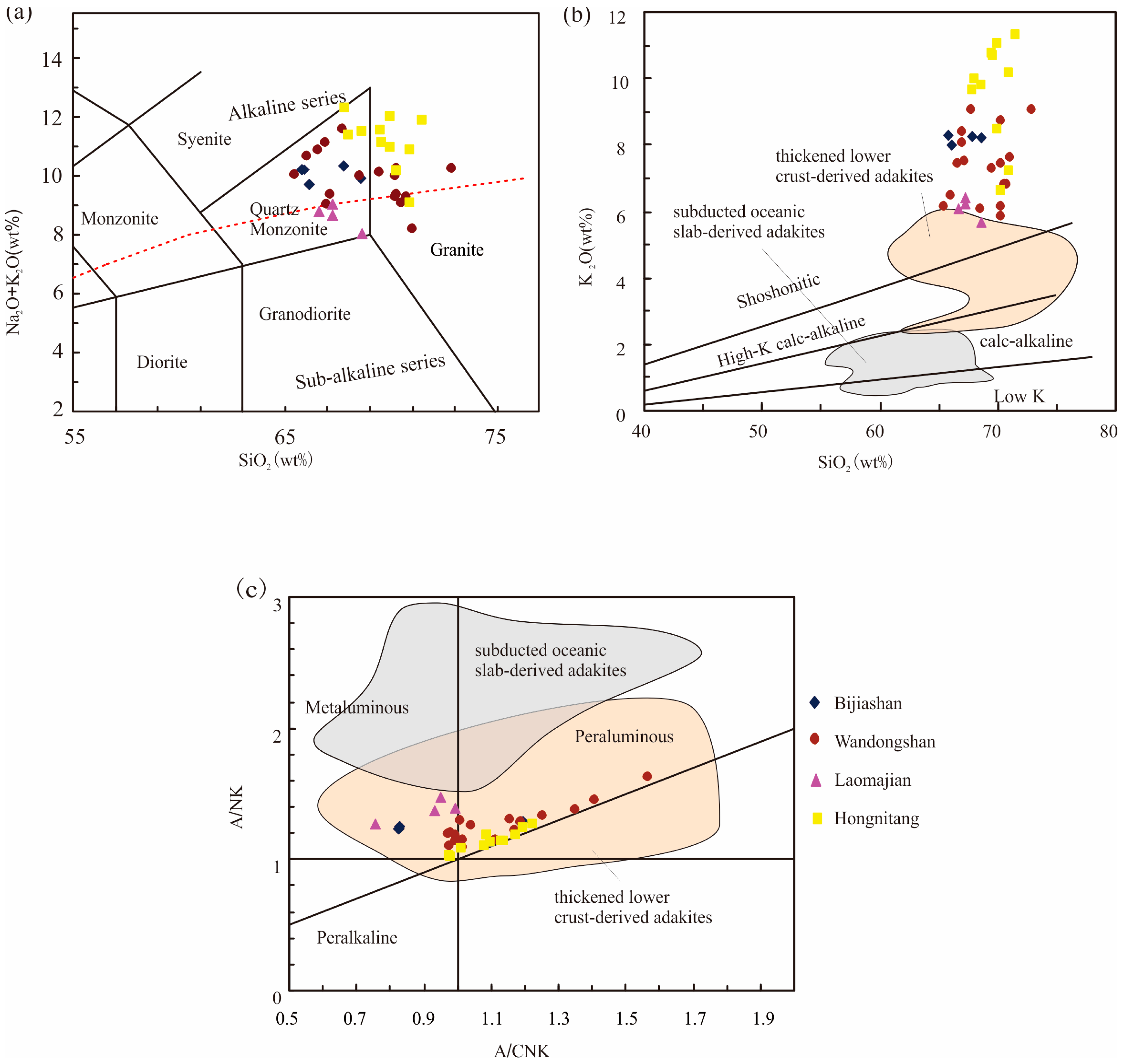
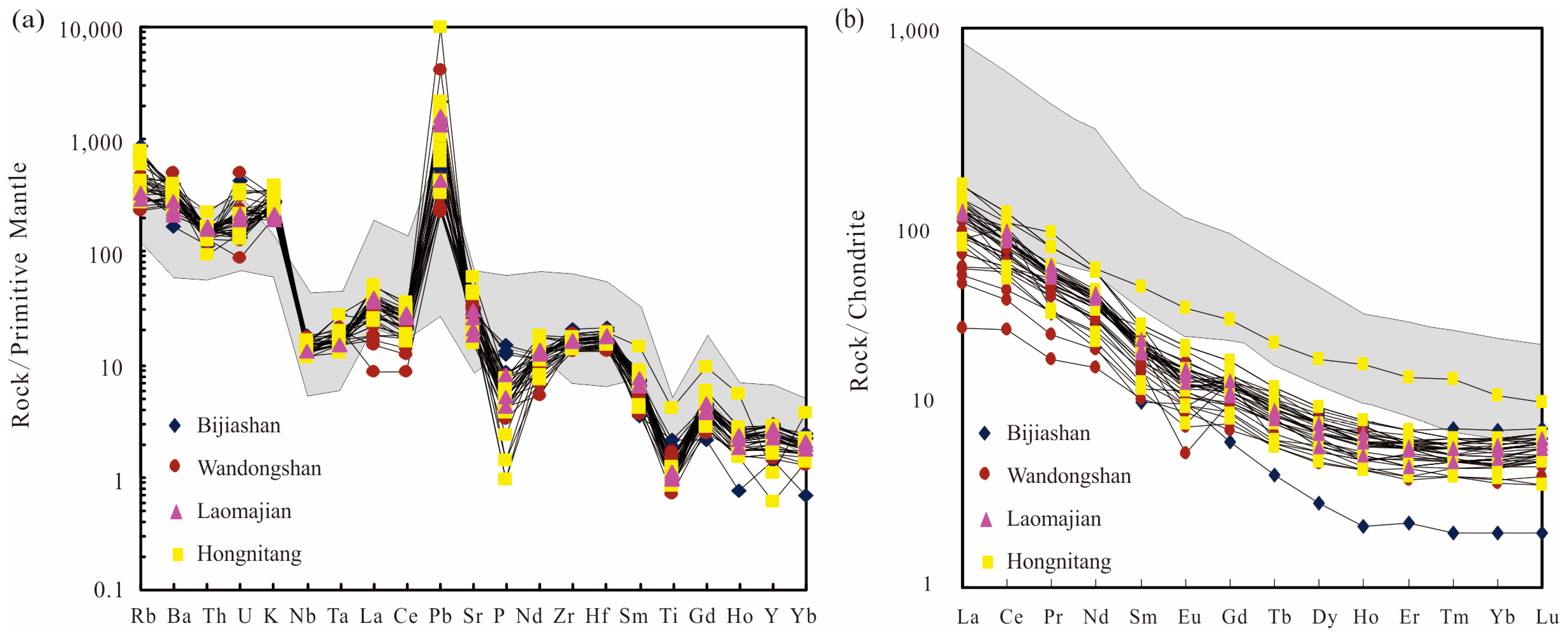
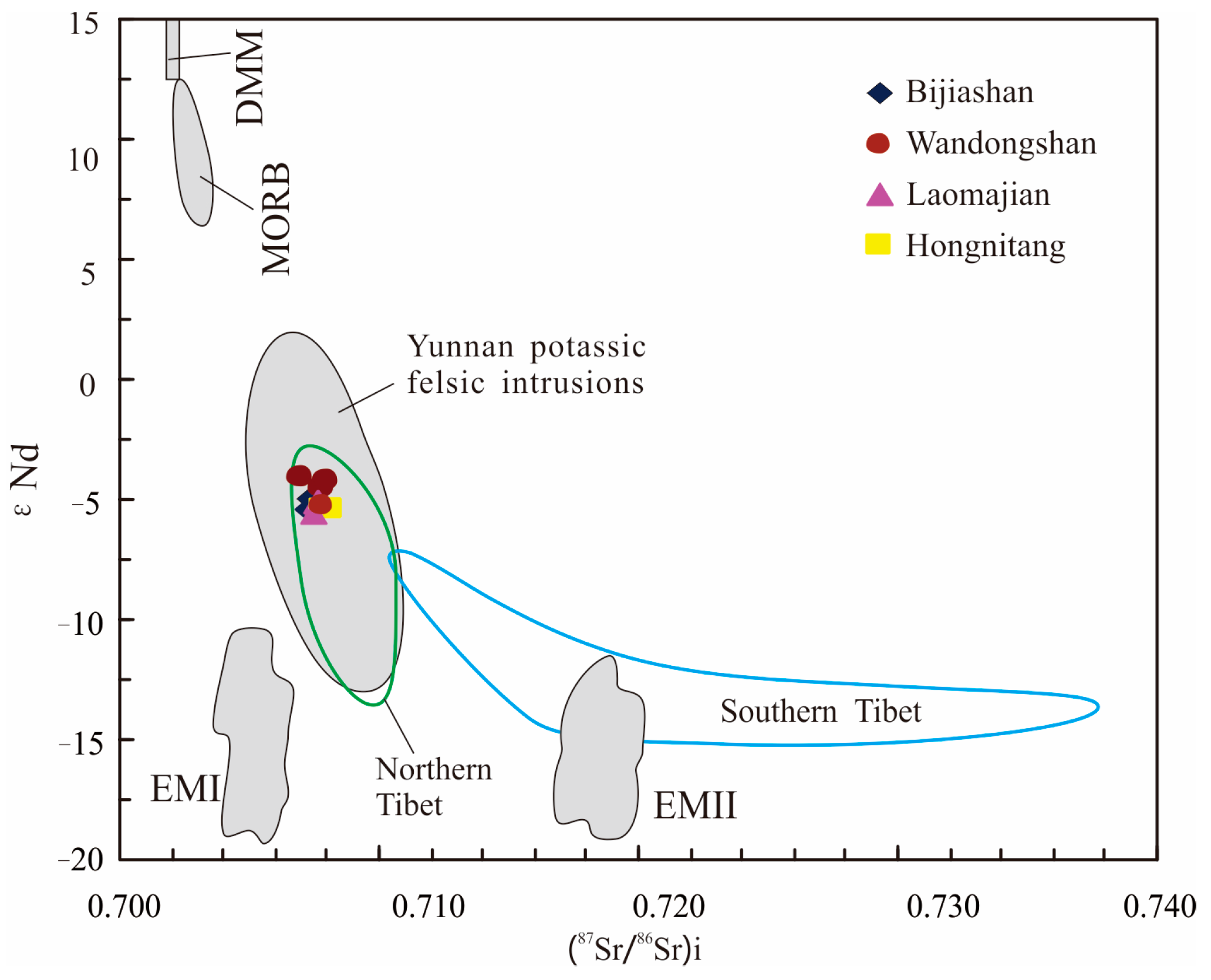
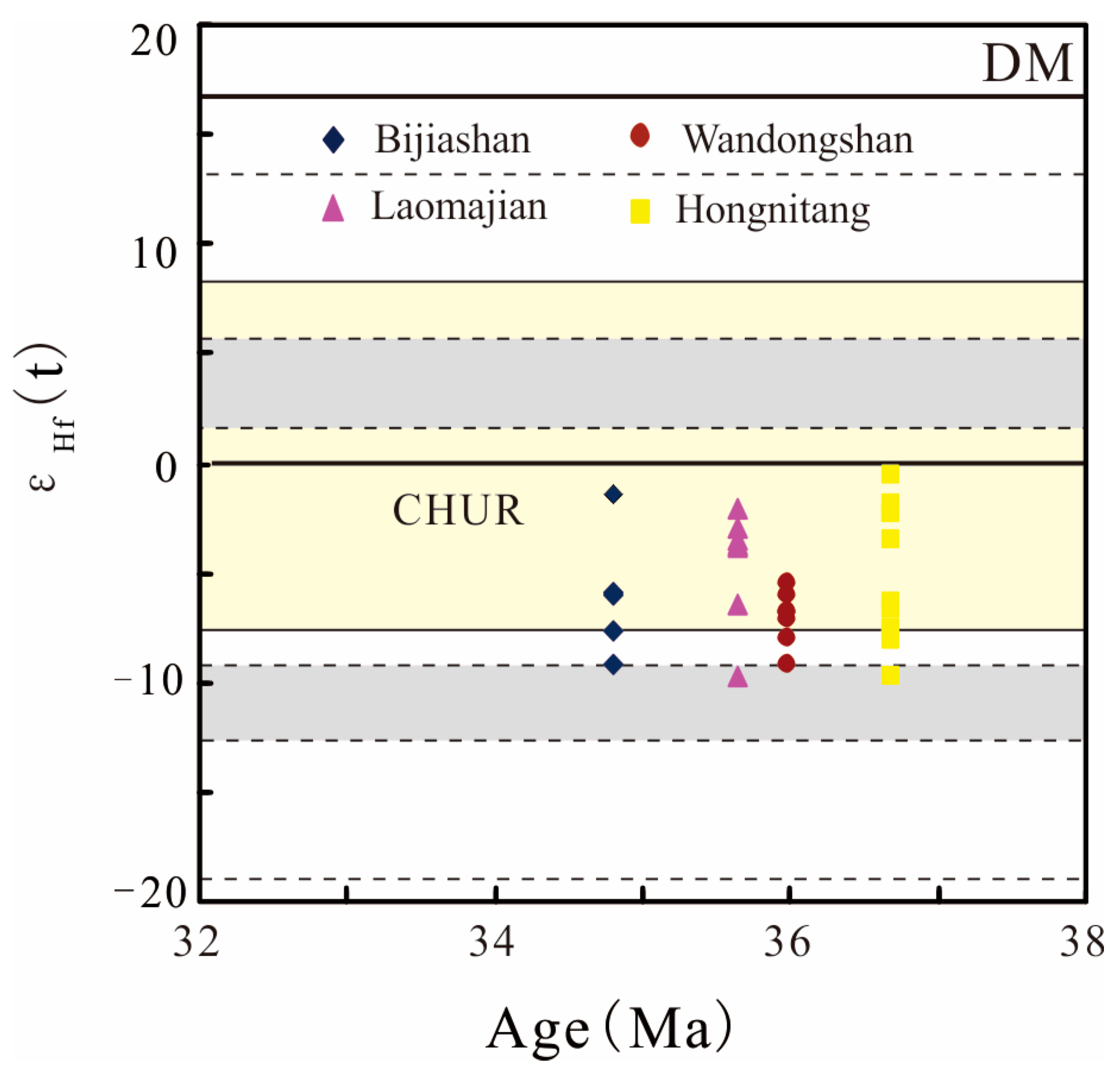
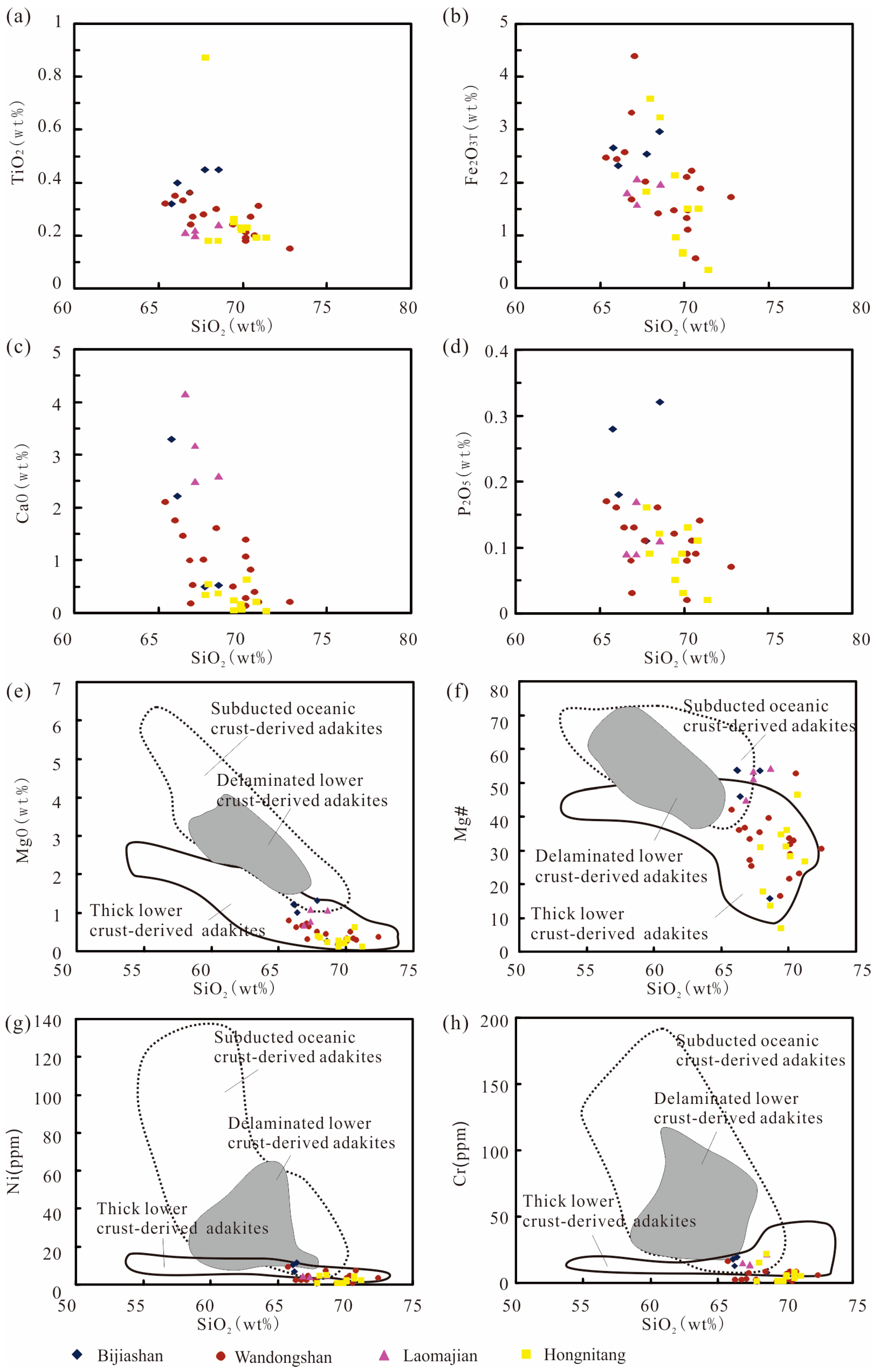
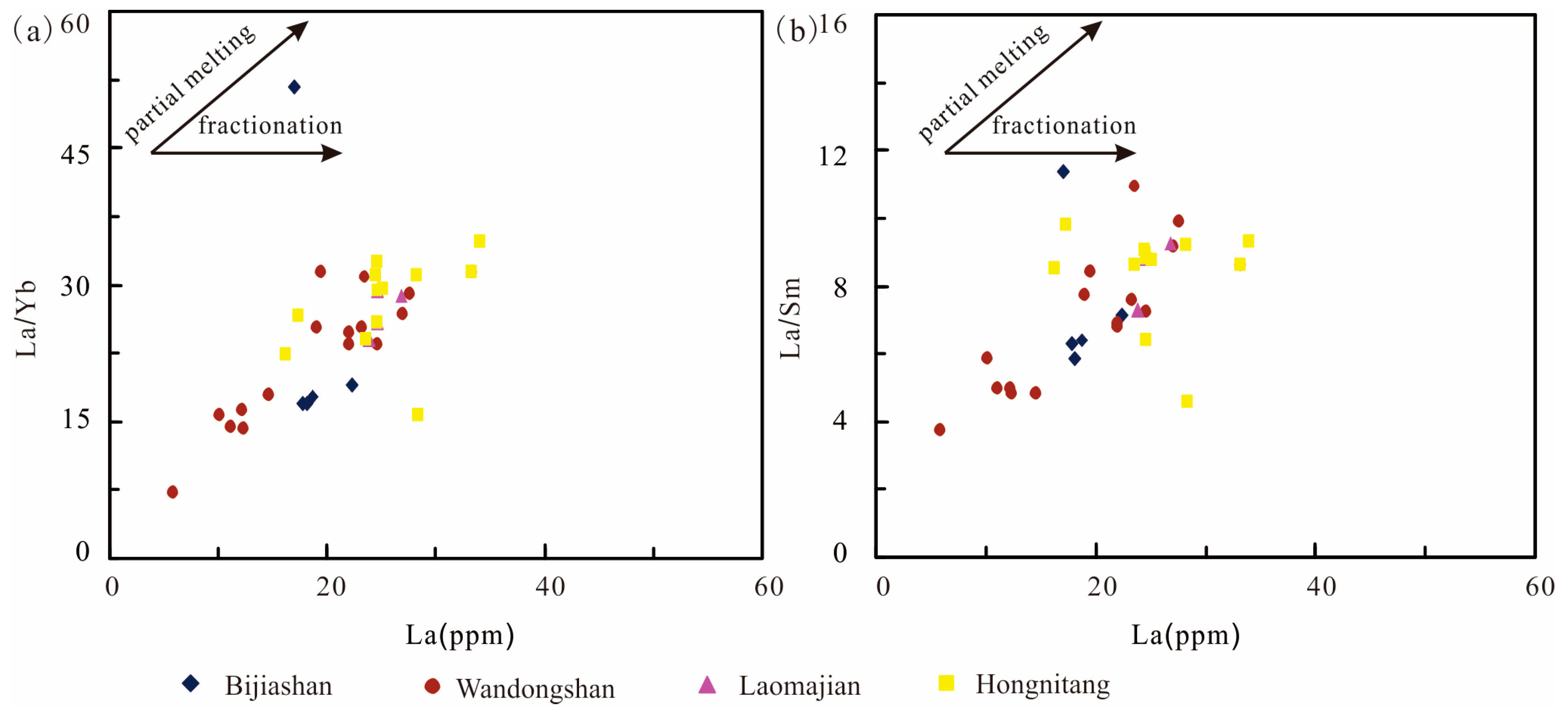
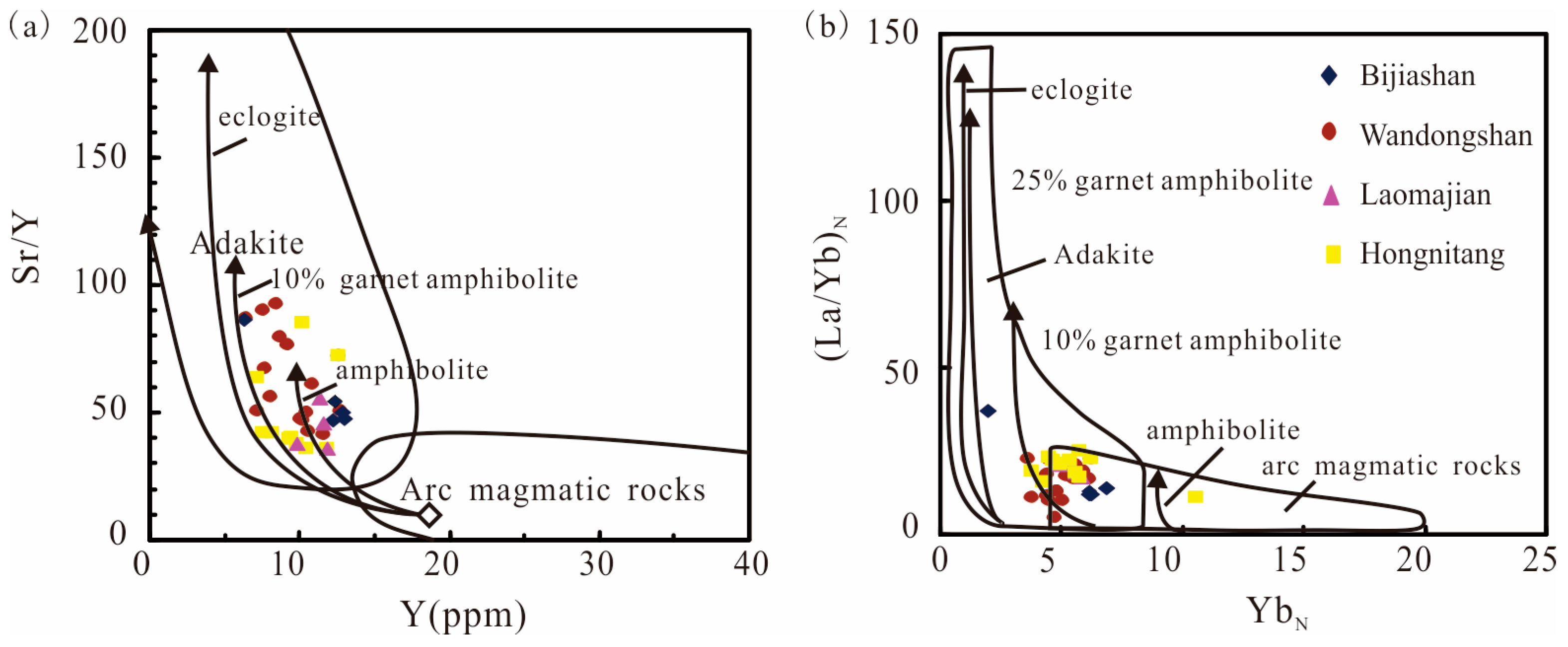
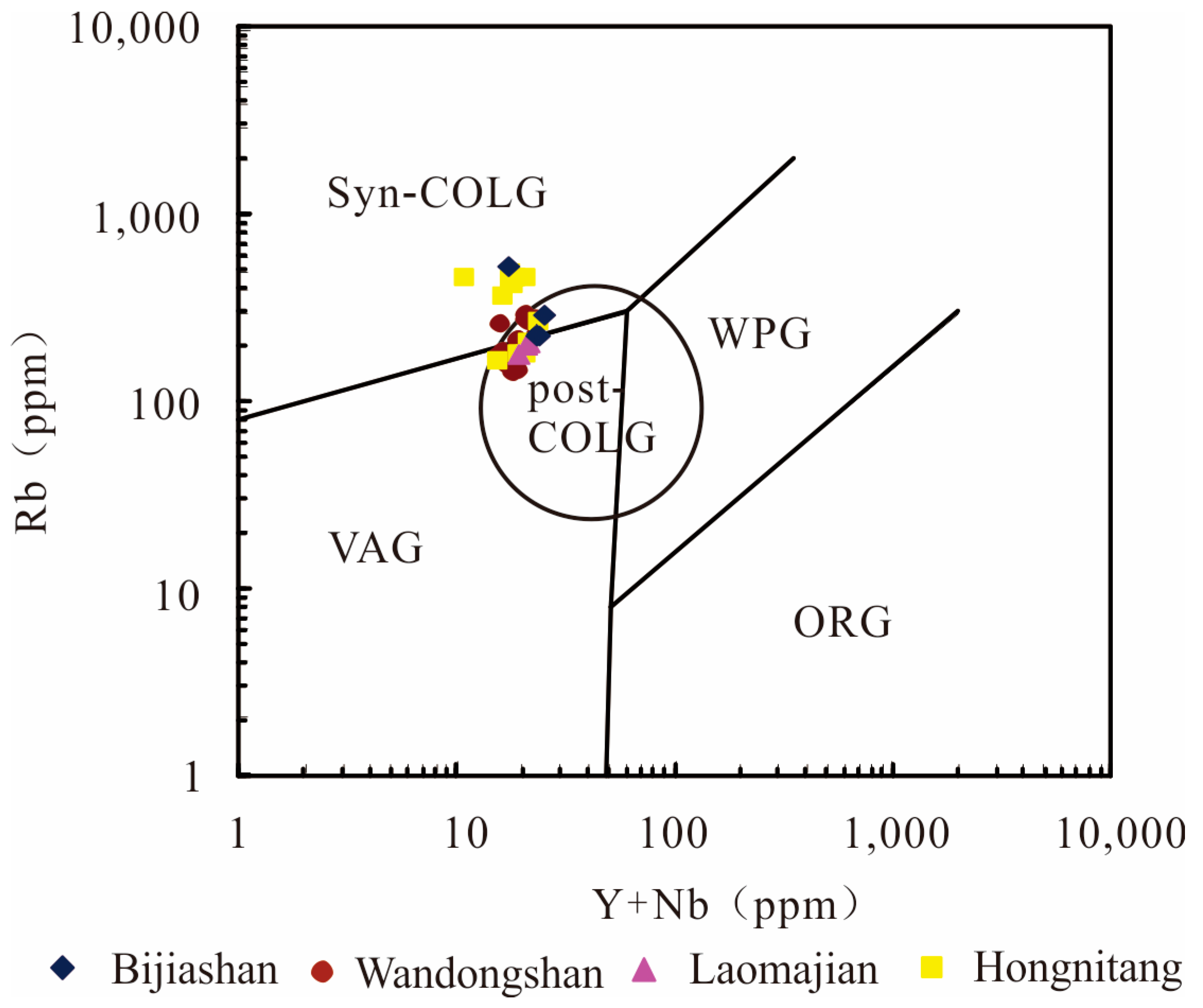
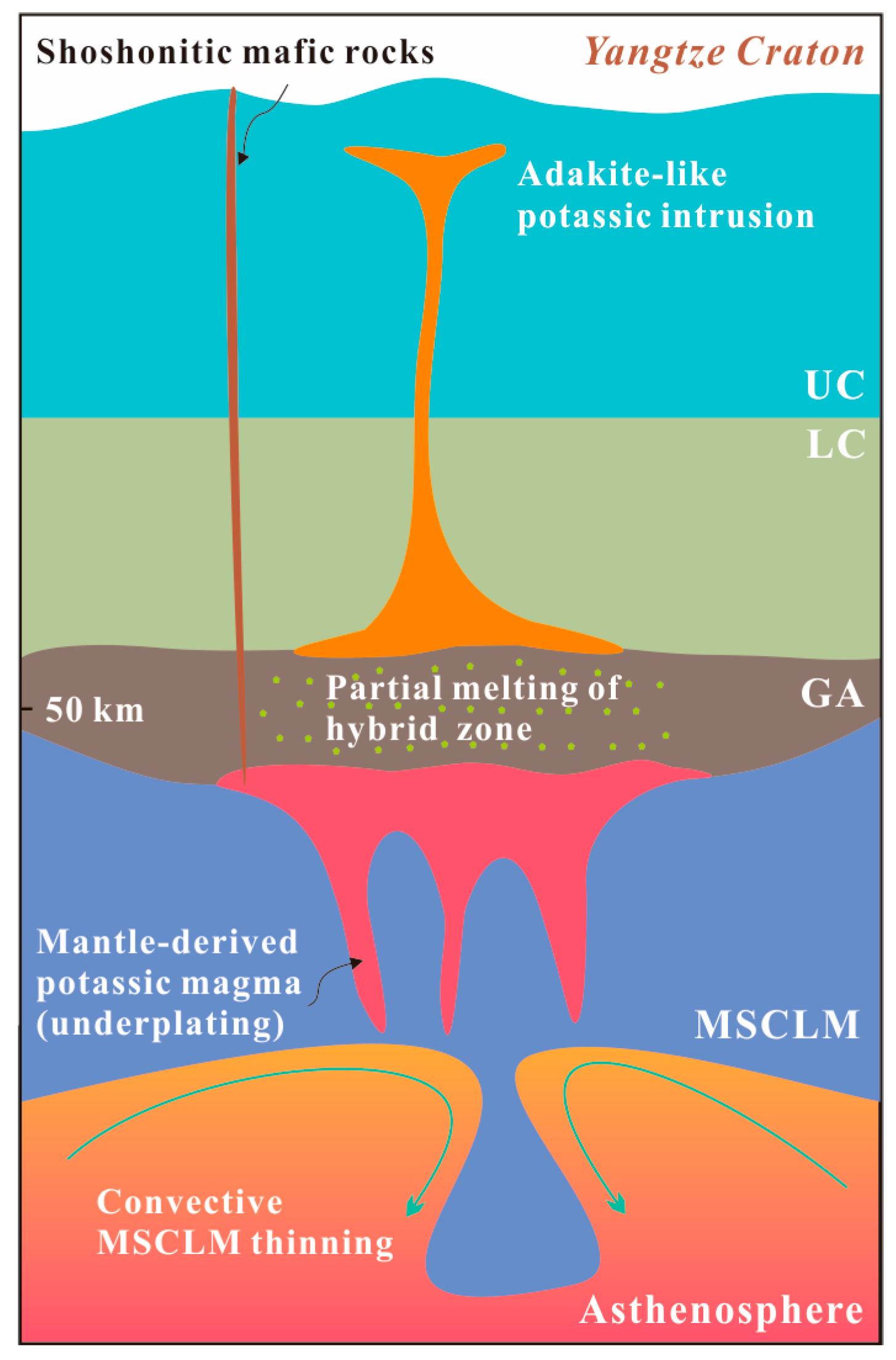
Disclaimer/Publisher’s Note: The statements, opinions and data contained in all publications are solely those of the individual author(s) and contributor(s) and not of MDPI and/or the editor(s). MDPI and/or the editor(s) disclaim responsibility for any injury to people or property resulting from any ideas, methods, instructions or products referred to in the content. |
© 2025 by the authors. Licensee MDPI, Basel, Switzerland. This article is an open access article distributed under the terms and conditions of the Creative Commons Attribution (CC BY) license (https://creativecommons.org/licenses/by/4.0/).
Share and Cite
Zhong, Y.; Yuan, Y.; Lu, Y.; Xia, B. Origin and Tectonic Implication of Cenozoic Alkali-Rich Porphyry in the Beiya Au-Polymetallic Deposit, Western Yunnan, China. Minerals 2025, 15, 531. https://doi.org/10.3390/min15050531
Zhong Y, Yuan Y, Lu Y, Xia B. Origin and Tectonic Implication of Cenozoic Alkali-Rich Porphyry in the Beiya Au-Polymetallic Deposit, Western Yunnan, China. Minerals. 2025; 15(5):531. https://doi.org/10.3390/min15050531
Chicago/Turabian StyleZhong, Yun, Yajuan Yuan, Ye Lu, and Bin Xia. 2025. "Origin and Tectonic Implication of Cenozoic Alkali-Rich Porphyry in the Beiya Au-Polymetallic Deposit, Western Yunnan, China" Minerals 15, no. 5: 531. https://doi.org/10.3390/min15050531
APA StyleZhong, Y., Yuan, Y., Lu, Y., & Xia, B. (2025). Origin and Tectonic Implication of Cenozoic Alkali-Rich Porphyry in the Beiya Au-Polymetallic Deposit, Western Yunnan, China. Minerals, 15(5), 531. https://doi.org/10.3390/min15050531






